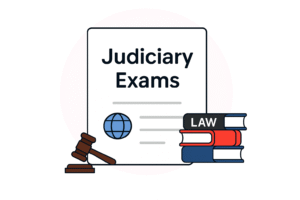The Basic Structure Doctrine is not just another concept in constitutional law, it’s the bedrock upon which modern Indian jurisprudence stands. Introduced by the judiciary to preserve the sanctity of the Constitution, it acts as a silent guardian, ensuring that the spirit of the Constitution isn’t diluted over time.
In this blog, we’ll walk through its origins, evolution, key elements, and major cases like Kesavananda Bharati, Minerva Mills, and Indira Gandhi Vs Raj Narain. Whether you’re new to the topic or need a crisp revision, we’ve got you covered, with clarity, simplicity, and a touch of sparkle!
Origins of the Basic Structure Doctrine

The doctrine evolved as a response to potential abuse of Article 368, which grants Parliament the power to amend the Constitution. Its foundation was laid in the historic Kesavananda Bharati v. State of Kerala (1973) case, where the Supreme Court ruled that Parliament can amend the Constitution but cannot alter its “basic structure.”
🌐 International Influence: The idea also draws inspiration from the German Constitution, which protected key democratic principles after the Nazi era.
Key Elements of the Basic Structure Doctrine
The Supreme Court has not given a fixed list of what constitutes the “Basic Structure,” but through multiple judgments, the following elements have been recognized:
- Supremacy of the Constitution
- Separation of Powers (Legislature, Executive & Judiciary)
- Rule of Law
- Judicial Review
- Fundamental Rights (Articles 14, 19, 21)
- Federalism
- Free & Fair Elections
These principles ensure that no government can erode the core values of democracy.
Landmark Cases Involving the Basic Structure Doctrine

- Shankari Prasad Vs Union of India (1951) – SC upheld Parliament’s power to amend any part of the Constitution, including Fundamental Rights.
- Golaknath Vs State of Punjab (1967) – SC ruled that Parliament cannot amend Fundamental Rights, setting the stage for future debates.
- Kesavananda Bharati Vs State of Kerala (1973) – Introduced the Basic Structure Doctrine, ensuring that amendments do not destroy core constitutional principles.
- Indira Gandhi Vs Raj Narain (1975) – Struck down an amendment exempting the PM’s election from judicial review, protecting judicial independence.
- Minerva Mills Vs Union of India (1980) – Reinforced that Judicial Review & the balance between Fundamental Rights and Directive Principles are part of the Basic Structure.
- I.R. Coelho Vs State of Tamil Nadu (2007) – Ruled that laws placed in the Ninth Schedule could still be struck down if they violate the Basic Structure.
The Doctrine in Action
This doctrine gives the Judiciary the power to review amendments made by Parliament. It acts as a safeguard against any attempt to dilute the Constitution’s fundamental values .
Example: NJAC Case (2015) – The Supreme Court struck down the National Judicial Appointments Commission (NJAC) Act, ruling that it violated judicial independence; a core part of the Basic Structure.
Conclusion: Why This Matters for Judiciary Aspirants
📈 The Kesavananda Bharati case remains one of the most important judgments in Indian constitutional law. Understanding the Basic Structure Doctrine is crucial for judiciary exams and legal careers.
To ace your judiciary preparation, you need concept clarity, structured study materials, and expert guidance. This is where Edzorb Law comes in!
🔗 Join Edzorb Law for:
- Concise yet comprehensive explanations
- Interactive learning
- Expert mentorship
Get started with Edzorb Law today!
Your judiciary preparation just got easier! 🎉


 Podcast
Podcast























